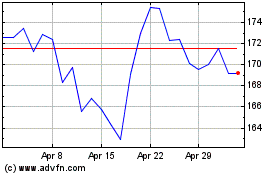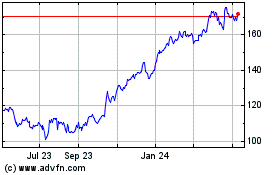A.M. Best Affirms Ratings of The Allstate Corporation and Its Subsidiaries
December 15 2010 - 11:59AM
Business Wire
A.M. Best Co. has affirmed the financial strength rating
(FSR) of A+ (Superior) and issuer credit ratings (ICR) of “aa-” of
Allstate Insurance Group (Allstate) and its members.
Additionally, A.M. Best has affirmed the ICR of “a-” and debt
ratings of Allstate’s parent, The Allstate Corporation
(Allcorp) (Northbrook, IL) (NYSE: ALL). The outlook for these
ratings is stable.
Concurrently, A.M. Best has affirmed the FSR of A+ (Superior)
and ICRs of “aa-” of the primary life/health insurance member
companies of Allstate Financial. A.M. Best also has affirmed
the debt ratings of “aa-” of the outstanding notes issued under
various funding agreement-backed securities (FABS) programs of
Allstate Life Insurance Company (ALIC) (Northbrook, IL). The
outlook for these ratings remains negative. (See link below for a
detailed listing of the companies and ratings.)
The ratings reflect Allstate’s solid risk-adjusted
capitalization, favorable operating performance and significant
market presence. The group’s capital position reflects its
profitable earnings, which have contributed to surplus growth over
the past five-year period, excluding parental dividends. Allstate's
non-catastrophe operating results have been favorable, as a result
of enhanced pricing sophistication and improved loss costs.
Additionally, Allstate has a strong overall business profile as the
second-largest personal lines writer in the United States.
Furthermore, Allstate maintains moderate financial leverage as well
as additional liquidity at the holding company level at both
Allcorp and Kennett Capital, Inc., and through access to capital
markets, lines of credit and its commercial paper program. The
group’s operating returns compare favorably to its industry
composite peers due to its solid underwriting capabilities and
investment income.
Partially offsetting these positive rating attributes is
Allstate's inherent exposure to natural disasters due to its
expansive market presence throughout the United States. This
exposure has been evident in recent years as net catastrophe losses
totaled $3.3 billion in 2008, $2.1 billion in 2009 and $1.7 billion
through September 2010, with an overall combined ratio impact of
12.4 points, 7.9 points and 8.6 points, respectively. However, in
recent years, Allstate has executed an extensive catastrophe risk
exposure reduction program, which includes a significantly enhanced
property catastrophe reinsurance program, non-renewals, stricter
underwriting guidelines, increased deductibles and discontinuance
of selected lines of coverage, including earthquake.
Additionally, Allstate has made large dividend payments to
Allcorp in most of the past five years, which have contributed to
volatility in risk-adjusted capitalization at times of heightened
losses. In addition, relative to industry norms, the group
maintains above average underwriting and investment leverage,
further exposing its surplus position to potential volatility, as
demonstrated in recent years. However, due to more recent reduced
investment risk and correspondingly lower investment losses,
combined with profitable underwriting performance, Allstate has
been able to generate solid organic surplus growth and improve its
risk-adjusted capitalization.
The ratings of the primary life/health insurance members of
Allstate Financial benefit significantly from the financial
strength and support of their immediate parent, Allstate, as well
as the ultimate parent, Allcorp. A.M. Best believes this support
demonstrates Allstate and Allcorp’s continued commitment to
Allstate Financial and, in A.M. Best’s opinion, the operations of
Allstate Financial remain strategically important to Allstate.
Allstate Financial’s ratings also benefit from the strong Allstate
brand-name recognition as well as the competitive advantages
derived from Allstate’s exclusive agent field force that provides
Allstate Financial significant cross-selling opportunities with
Allstate’s vast customer base. In addition, the rating action
reflects Allstate Financial’s competitive market positions, wide
array of protection and voluntary health products, complementary
distribution networks and adequate level of risk-adjusted
capitalization. Furthermore, A.M. Best continues to view favorably
Allstate Financial’s new business direction, whereby spread-based
products have been voluntarily de-emphasized, with more focus
placed on growing its core protection products and workplace
supplemental health products.
Offsetting these positive factors are Allstate Financial’s
modest operating trends that have been dampened in recent years by
significant investment losses triggered primarily by the fallout of
the credit market meltdown, the challenges of the continuing low
interest rate environment, and “one-time” charges. While A.M. Best
views positively Allstate Financial’s new strategic business
direction, it will continue to be challenged to administer its
large—albeit declining—exposure to spread-based liabilities that
continue to expose Allstate Financial to interest rate, credit,
reinvestment and disintermediation risks. Finally, while A.M. Best
acknowledges the significant improvement in Allstate Financial’s
fixed-income portfolio—the portfolio is currently in a large
unrealized gain position—there remains the potential for additional
asset impairments should the current fragile economic recovery
stall or deteriorate as several structured asset classes continue
to maintain large unrealized loss positions. Additionally, while
Allstate Financial’s large direct commercial mortgage loan
portfolio has performed reasonably well, it also could experience
higher delinquencies should the commercial mortgage markets
soften.
For a complete listing of The Allstate Corporation and its
property/casualty and life/health subsidiaries’ FSRs, ICRs and debt
ratings, please visit www.ambest.com/press/121505allstate.pdf.
The principal methodology used in determining these ratings is
Best’s Credit Rating Methodology -- Global Life and Non-Life
Insurance Edition, which provides a
comprehensive explanation of A.M. Best’s rating process and
highlights the different rating criteria employed. Additional key
criteria utilized include: “Risk Management and the Rating Process
for Insurance Companies”; “Understanding BCAR for Property/Casualty
Insurers”; “Catastrophe Risk Management Incorporated Within the
Rating Analysis”; “Understanding BCAR for Life and Health
Insurers”; “A.M. Best’s Ratings & the Treatment of Debt”; “A.M.
Best’s Perspective on Operating Leverage”; “Equity Credit for
Hybrid Securities”; “Rating Funding Agreement-Backed Securities”;
and “Rating Members of Insurance Groups.” Methodologies can be
found at www.ambest.com/ratings/methodology.
Founded in 1899, A.M. Best Company is the
world's oldest and most authoritative insurance rating and
information source. For more information, visit
www.ambest.com.
Copyright © 2010 by A.M. Best Company,
Inc. ALL RIGHTS RESERVED.
Allstate (NYSE:ALL)
Historical Stock Chart
From May 2024 to Jun 2024

Allstate (NYSE:ALL)
Historical Stock Chart
From Jun 2023 to Jun 2024
